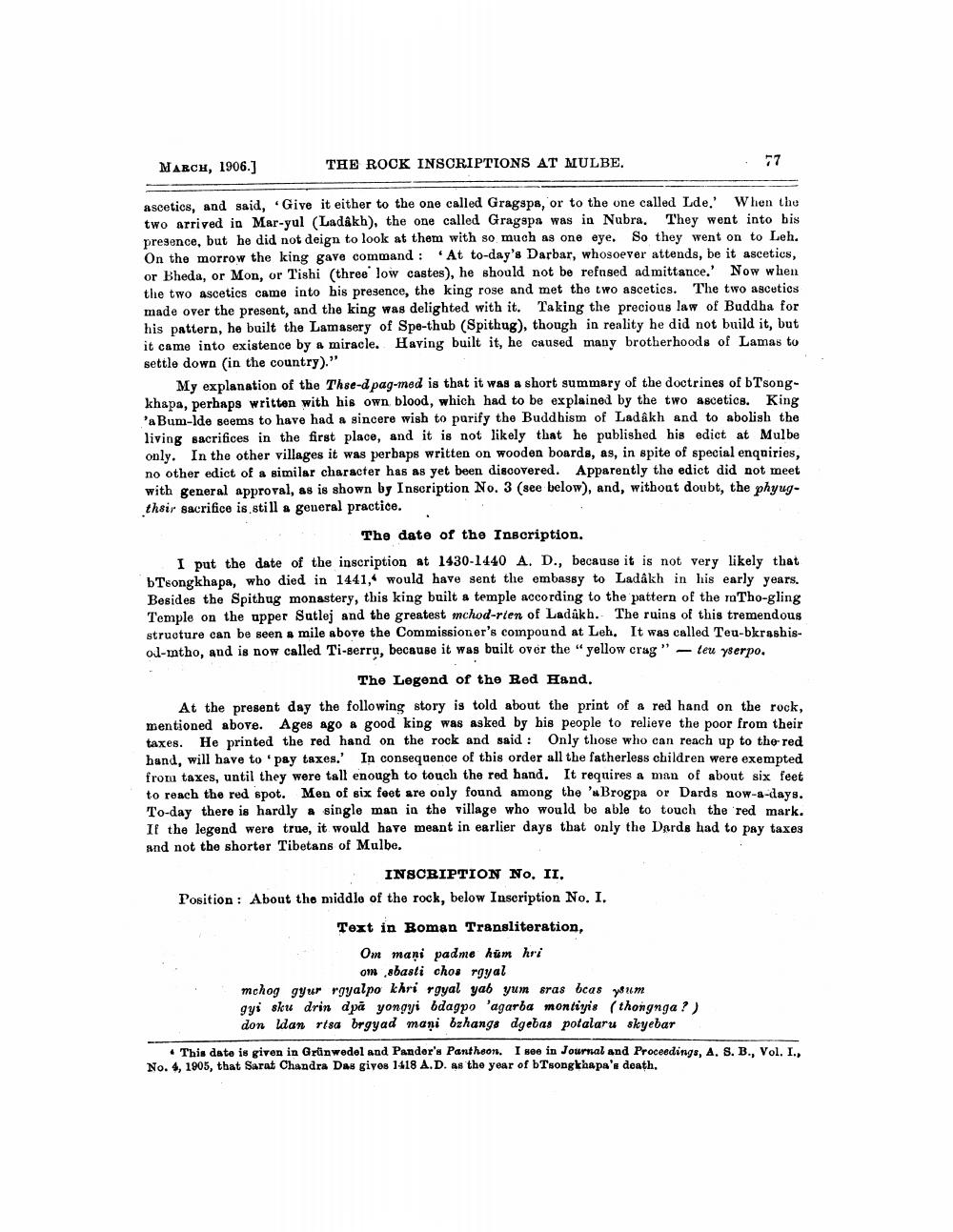________________
MARCH, 1906.]
THE ROCK INSCRIPTIONS AT MULBE.
ascetics, and said, "Give it either to the one called Gragspa, or to the one called Lde. When the two arrived in Mar-yul (Ladakh), the one called Gragspa was in Nubra. They went into bis presence, but he did not deign to look at them with so much as one eye. So they went on to Leh. On the morrow the king gave command : At to-day's Darbar, whosoever attends, be it ascetics, or Bheda, or Mon, or Tishi (three low castes), he should not be refused admittance. Now when the two ascetics came into his presence, the king rose and met the two ascetics. The two ascetics made over the present, and the king was delighted with it. Taking the precious law of Buddha for his pattern, he built the Lamasery of Spe-thub (Spithug), though in reality he did not build it, but it came into existence by a miracle. Having built it, he caused many brotherhoods of Lamas to settle down in the country)."
My explanation of the Thse-d pag-mod is that it was a short summary of the doctrines of bTsongkhapa, perhaps written with his own blood, which had to be explained by the two ascetics. King 'a Bum-lde seems to have had a sincere wish to purify the Buddhism of Ladakh and to abolish the living sacrifices in the first place, and it is not likely that he published his edict at Mulbe only. In the other villages it was perbaps written on wooden boards, as, in spite of special enqniries, no other edict of a similar character has as yet been discovered. Apparently the edict did not meet with general approval, as is shown by Inscription No. 3 (see below), and, without doubt, the phyugthsir sacrifice is still a general practice.
The date of the Inscription. I put the date of the inscription at 1430-1440 A. D., because it is not very likely that bTsongkhapa, who died in 1441, would have sent the embassy to Ladakh in his early years. Besides the Spithug monastery, this king built a temple according to the pattern of the ro Tho-gling Temple on the upper Sutlej and the greatest mchod-rten of Ladakh. The ruins of this tremendous structure can be seen a mile above the Commissioner's compound at Leh. It was called Teu-bkrashisol-intho, and is now called Ti-serru, because it was built over the "yellow crag" - teu yserpo.
The Legend of the Red Hand. At the present day the following story is told about the print of a red hand on the rock, mentioned above. Ages ago a good king was asked by his people to relieve the poor from their taxes. He printed the red hand on the rock and said: Only those who can reach up to the red hand, will have to pay taxes.' In consequence of this order all the fatherless children were exempted from taxes, until they were tall enough to touch the red hand. It requires a man of about six feet to reach the red spot. Men of six feet are ooly found among the 's Brogpa or Dards now-a-days. To-day there is hardly a single man in the village who would be able to touch the red mark. If the legend were true, it would have meant in earlier days that only the Dards had to pay taxes and not the shorter Tibetans of Mulbe.
INSCRIPTION No. II. Position : About the middle of the rock, below Inscription No. I.
Text in Roman Transliteration,
Om mani padme hüm hri
om ,sbasli chos rgyal mchog gyur rgyalpo khri rgyal yab yum sras bcas yeum gyi sku drin dpa yongyi bdagpo 'agarba montiyis (thongnga?) don Wan risa brgyad maņi bzhangs dgebas potalaru skyebar
This date is given in Grünwedol and Pandor's Pantheon. I see in Journal and Proceedings, A. S. B., Vol. I. No. 4, 1905, that Sarat Chandra Das gives 1418 A.D. as the year of Tsongkhapa's death,




